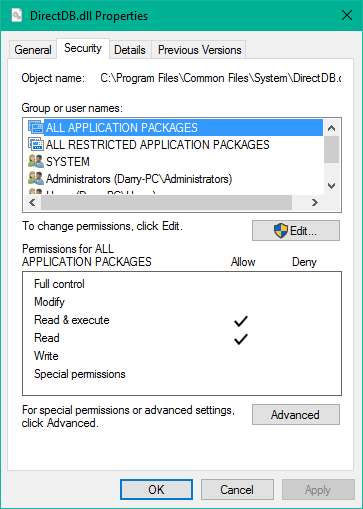

Press WIN+R to open the Run dialog box.If you want to reapply default security settings to a DC, use the defltdc.inf template instead. The default permissions that I’m going to apply using the command below are for servers that are not domain controllers (DCs).
#WINDOWS 7 DEFAULT PERMISSIONS RESET WINDOWS#
To perform the steps below, you’ll need to log in to Windows Server with an account that has local administrative permissions. For more information about using secedit and the GUI Security Configuration and Analysis Tool, see Using the Windows Server 2012 Security Configuration and Analysis Tool on Petri. Also, bear in mind that custom security settings you’ve defined in areas not covered by the security template won’t be rolled back. Reset Default Security ACLsīefore using the secedit tool to reset permissions, you might consider using the Security Configuration and Analysis Tool instead, as it allows you to compare current settings against those in a template. For more information about backing up Windows Server, see Back Up a Windows Server 2012 R2 Domain Controller on the Petri IT Knowledgebase.

You might also consider using s ecedit’s /generaterollback switch to create a template that would allow you to restore the security ACLs to their current state. But in a lab environment, you might decide it’s worth the risk.īack up and test a restore operation of your server before following the instructions below. Production systems are rarely configured without significant changes to the OS defaults, so applying a mass rollback of ACLs is likely to cause some issues. The method I’m going to show you in this article resets filesystem and registry ACLs to their defaults. But in cases where those measures have either failed or were not present to protect your systems, it might be necessary to reset permissions to their out-of-the-box defaults.

Prevention is better than cure, so adhering to security best practices is the best way to ensure that unwanted changes don’t cause any nasty surprises in your production environment, such as not granting IT staff permanent administrative access to servers and implementing a solid change control process.
#WINDOWS 7 DEFAULT PERMISSIONS RESET HOW TO#
Access control lists (ACLs) determine access to the filesystem and registry and can be changed manually, using Group Policy, or other tools, and untested modifications to default security settings can prove catastrophic.Ĭheck out this article on Petri about how to modify access control lists using icacls if you want to work with individual files. If you’ve ever been in a situation where Windows Server exhibits strange behavior, or even worse, something has stopped working completely, you might have traced the issue to changes in security permissions on files, folders, or registry keys.



 0 kommentar(er)
0 kommentar(er)
